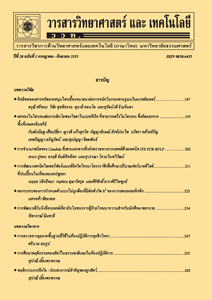ลักษณะพันธุกรรมของวัชพืชรุกรานต่างถิ่นผักตบชวาในประเทศไทย
Main Article Content
Abstract
บทคัดย่อ
ผักตบชวา [Eichhornia crassipes (Mart.) Solms] จัดเป็นวัชพืชน้ำรุกรานที่สร้างความเสียหายต่อประเทศไทย มีแหล่งกำเนิดในทวีปอเมริการใต้ สันนิษฐานว่านำเข้าจากประเทศอินโดนีเซียเมื่อร้อยกว่าปีที่ผ่านมา เพื่อให้เข้าใจในการควบคุมทางชีวภาพจำเป็นต้องทราบข้อมูลของลักษณะพันธุกรรมของผักตบชวา ทำการศึกษาโดยเก็บตัวอย่างจากตัวอย่างผักตบชวาจากทุกจังหวัดในประเทศไทย จากนั้นทดสอบความหลากหลายทางพันธุกรรมด้วยเทคนิคเอสอาร์เอพี (sequence related amplification polymorphism, SRAP) และเทคนิคไอพีบีเอส (inter primer binding sites, iPBS) จากตัวอย่างประชากรใน 77 จังหวัด โดยเก็บตัวอย่างจังหวัดละ 3 ตัวอย่าง พบว่าเทคนิคเอสอาร์เอพีใช้ไพรเมอร์ 30 คู่ ให้แถบดีเอ็นเอ 356 แถบ และเทคนิคไอพีบีเอสใช้ไพรเมอร์ 20 ไพรเมอร์ ให้แถบดีเอ็นเอ 231 แถบ ผลการศึกษาแสดงให้เห็นว่ารูปแบบพันธุกรรมของผักตบชวาในประเทศไทยมีลักษณะเหมือนกันทุกประชากร ดังนั้นการรุกรานของผักตบชวาในประเทศไทยน่าจะพัฒนามาจากต้นสายพันธุกรรมเดียวกัน ข้อเสนอแนะที่ได้จากข้อมูลที่ได้พบว่าในพื้นที่ระบาดของประเทศไทยผักตบชวาไม่มีความหลากหลายทางพันธุกรรม ดังนั้นอาจใช้ศัตรูทางธรรมชาติจากพื้นที่ต้นกำเนิดเพื่อใช้เป็นตัวควบคุมทางชีวภาพได้
คำสำคัญ : ผักตบชวา; วัชพืชรุกราน; เอสอาร์เอพี; ไอพีบีเอส
Abstract
Water hyacinth [Eichhornia crassipes (Mart.) Solms] is an aggressive invasive aquatic weed of Thailand. Native to South America, the species is believed to have been initially introduced into Thailand from the Indonesia since hundred years ago. To provide insight into the potential for biological control of E. crassipes, genetic characterization of plants sampled from all provinces in Thailand were analyzed using sequence related amplification polymorphism (SRAP) and inter primer binding sites (iPBS) molecular markers. Invasive individuals from 77 provinces by three samples in each province were genetically fingerprinted using 30 SRAP primer combinations and 20 iPBS primers, 356 SRAP bands and 231 iPBS bands were produced respectively. Water hyacinth exhibited the same genotype indicating a single genetic clone. A lack of genetic diversity in the invaded range simplifies identification of native source populations to search for natural enemies that could be used as biocontrol agents.
Keywords: Eichhornia crassipes; invasive weed; SRAP; iPBS


